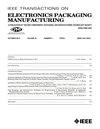A Study of Crack Propagation in Pb-Free Solder Joints
IEEE Transactions on Electronics Packaging Manufacturing
Pub Date : 2010-03-15
DOI:10.1109/TEPM.2009.2039710
引用次数: 9
Abstract
The higher stiffness of Pb-free SAC solders makes Pb-free assemblies more sensitive to drop impact. In order to be able to optimize the drop test performance, it is necessary to have better insight into the crack propagation in the Pb-free solder joints. This study combines crack-front mapping using the dye and pry method and electrical FE simulation to establish a relation between DC electrical resistance and cracked area, and hence monitor the initiation and propagation of cracks in individual solder joints as the PCB assemblies are subjected to JEDEC type mechanical shock and high speed cyclic bending. The carrier in the study is a ball grid array (BGA), a critical component family for drop impact. Combinations of solder alloys and pad finishes, SnPb on organic solderable preservative (OSP), SAC305 on electroless nickel/immersion gold (ENIG), SAC101 on OSP, and SAC101(d) on ENIG are studied regarding the failure mode and crack propagation. This paper demonstrates that, for the large majority of Pb-free solder joints, there is a negligible initiation period; cracks can start forming at the first PCB bending cycle. The presence of large cracks, especially at both sides can increase the compliance of the joint and slow down crack growth. Even if large cracks are present, the resistance increase is less than 1 m¿ per interconnect, which is far from the 100 ¿ that is often taken as a failure criterion. Brittle joints as found with SAC305 on ENIG have erratic propagation rates while ductile joints are much more predictable. Therefore, the way to optimize the drop test performance of a Pb-free BGA assembly is to prolong the crack propagation within the ductile bulk solder material.无铅焊点裂纹扩展的研究
无铅SAC焊料具有较高的刚度,使得无铅组件对跌落冲击更加敏感。为了能够优化跌落测试性能,有必要更好地了解无铅焊点的裂纹扩展。本研究结合了使用染料和探针方法的裂纹前映射和电有限元模拟,建立了直流电阻与裂纹面积之间的关系,从而监测了当PCB组件遭受JEDEC型机械冲击和高速循环弯曲时单个焊点裂纹的产生和扩展。研究中的载体是球栅阵列(BGA),这是一种用于液滴冲击的关键组件族。研究了焊料合金和焊盘表面活性剂、有机可焊防腐剂(OSP)上的SnPb、化学镍/浸金(ENIG)上的SAC305、OSP上的SAC101和ENIG上的SAC101(d)的组合对失效模式和裂纹扩展的影响。本文表明,对于绝大多数无铅焊点,起始时间可以忽略不计;裂纹可以在第一个PCB弯曲循环中开始形成。大裂纹的存在,特别是在两侧,可以增加接头的柔度,减缓裂纹的扩展。即使存在较大的裂纹,每个互连线的电阻增量也小于1 μ m,这与通常作为失效准则的100 μ m相距甚远。在ENIG上发现SAC305的脆性接头具有不稳定的扩展速率,而延性接头更具可预测性。因此,优化无铅BGA组件跌落测试性能的方法是延长延展性大块钎料内的裂纹扩展。
本文章由计算机程序翻译,如有差异,请以英文原文为准。
求助全文
约1分钟内获得全文
求助全文

 求助内容:
求助内容: 应助结果提醒方式:
应助结果提醒方式:


